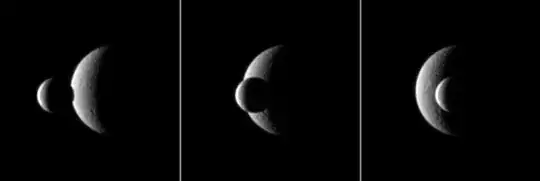So I found this site through this other question asking generally about what Earth would be like with two moons. However, these responses, like pretty much everything else I've been able to find insofar on the internet, deal with if the second moon was the same or bigger size, existed in a separate plane from our Moon, was in a differently shaped orbit, heavily affected the tides, etc. What I'm looking for is: how small would a second moon have to be in order to only minimally affect the gravitational pulls on both the Moon and Earth, and then also the tides?
I really want to be able to put something like Saturn's occasional moon transiting/crossing into my fantasy story. An example of that are these pictures I found of Saturn's much smaller moon, Enceladus, passing in front of a larger moon, Rhea.
So, like Enceladus here, because of the Moon's already larger than usual size in comparison to Earth, how small would a second moon have to be in order to exist with a similar smaller scale orbit between the Moon and Earth, without affecting anything too drastically? Alternatively, is it possible to have a smaller moon that can be seen without changing things too much, or not?
If it wouldn't be able to be seen, then theoretically how much smaller would the original Moon need to be in order to make this work? I'm incorporating this in a fantasy world with completely original continents/land-forms so as long as I could realistically keep the Earth's environment types intact on it, I'm not so attached to keeping the Moon as large it is. I just really want two moons, lol.
EDIT: I thought it was clear, but what all of my questions are for is I'm asking if there is a way/multiple ways that an Earth-like planet could have two moons in orbit without it becoming unstable. And I'm asking for details - what would the general sizes look like, what the differences would have to result in (such as the tides), etc. Yes I want two moons, but if it wouldn't be realistic, I won't throw them in.
